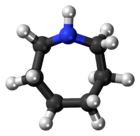Azepane
(Redirected from Hexamethyleneimine)
| |||
| Names | |||
|---|---|---|---|
| Preferred IUPAC name
Azepane | |||
Other names
| |||
| Identifiers | |||
3D model (JSmol)
|
|||
| ChEBI | |||
| ChEMBL | |||
| ChemSpider | |||
| ECHA InfoCard | 100.003.524 | ||
PubChem CID
|
|||
| UNII | |||
CompTox Dashboard (EPA)
|
|||
| |||
| |||
| Properties | |||
| C6H13N | |||
| Molar mass | 99.177 g·mol−1 | ||
| Appearance | colorless liquid | ||
| Density | 0.88 g/cm3[1] | ||
| Melting point | −37 °C (−35 °F; 236 K) | ||
| Boiling point | 138 °C (280 °F; 411 K)[1] (749 mmHg) | ||
| Hazards | |||
| Flash point | 30 °C (86 °F; 303 K) | ||
Except where otherwise noted, data are given for materials in their standard state (at 25 °C [77 °F], 100 kPa).
| |||
Azepane is the organic compound with the formula (CH2)6NH. It is a colorless liquid. A cyclic secondary amine, it is a precursor to several drugs and pesticides. It is produced by partial hydrogenolysis of hexamethylene diamine.[2]
Like many amines, it reacts with carbon dioxide.[3]
Azepane-containing drugs
- AK-1 [330461-64-8]
- Amicibone
- Bazedoxifene
- Bacmecillinam (KW 1100)
- Brazergoline
- BRN 1322519 [4082-37-5][4]
- Buzepide (Fenpipramide homolog).
- Cetiedil
- Gimantan
- Glidazamide
- Glisoxepide
- Glypinamide
- Hexacaine
- Mecillinam
- Molinate
- MR-16728 (cetiedil analogue)
- Nabazenil
- PD-157667
- PD-158143
- PD-151307
- Pincainide
- Prozapine
- Setastine
- Tolazamide
- UCL 1608 Fb: [371172-30-4] Oxalate Salt: [371172-31-5]
See also
References
- ^ a b "Hexamethyleneimine".
- ^ Karsten Eller; Erhard Henkes; Roland Rossbacher; Hartmut Höke (2005). "Amines, Aliphatic". Ullmann's Encyclopedia of Industrial Chemistry. Weinheim: Wiley-VCH. doi:10.1002/14356007.a02_001. ISBN 3527306730.
- ^ Sanz-Pérez, E. S.; Arencibia, A.; Sanz, R.; Calleja, G. (2016). "New developments on carbon dioxide capture using amine-impregnated silicas". Adsorption. 22 (4): 366–375. doi:10.1007/s10450-015-9740-2. S2CID 100692983.
- ^ Barron, D. I.; Hall, G. H.; Natoff, I. L.; Ridley, H. F.; Spickett, R. G. W.; Vallance, D. K. (1965). "Compounds Affecting the Central Nervous System. III. Substituted 1,1-Diaryl-t-aminopropanols and Related Compounds". Journal of Medicinal Chemistry. 8 (6): 836-841. doi:10.1021/jm00330a023.

